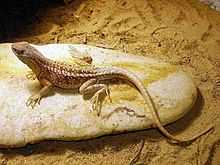Chalarodon madagascariensis
| Chalarodon madagascariensis | |
|---|---|
 | |
| Chalarodon madagascariensis | |
| Scientific classification | |
| Kingdom: | Animalia |
| Phylum: | Chordata |
| Class: | Sauropsida |
| Order: | Squamata |
| Suborder: | Lacertilia |
| Infraorder: | Iguania |
| Family: | Opluridae |
| Genus: | Chalarodon |
| Species: | C. madagascariensis |
| Binomial name | |
| Chalarodon madagascariensis Peters, 1854 | |
Chalarodon madagascariensis is a species of Malagasy terrestrial iguanian lizard native to western, southern, and south eastern Madagascar.[1] Until 2015, it was thought to be the only member of its genus, but a second species, C. steinkampi was recognised in 2015.[2] It is not yet clear if the distributional range of these two species overlaps.
Habitat
The species inhabits mainly coastal, semi-arid to arid regions and almost entirely open, or very sparsely vegetated habitats with sandy soil in the province of Toliara, and in the southwestern provinces of Fianarantsoa and Majunga in the southwest of Madagascar.
Distribution
This species is widespread in western, southern, and eastern Madagascar.[1]
Morphology
Calarodon madagascariensis is easiest distinguished from C. steinkampi by its keeled gular and ventral scales, which are unkeeled in the latter species.[2]
Nutrition
The Madagascar sand lizards are insectivores. In addition to insects, sometimes plants are ingested, particularly in the form of leaves and roots.
References
- ↑ 1.0 1.1 Glaw, Frank; Vences, Miguel (2007). A Field Guide to the Amphibians and Reptiles of Madagascar (3rd Edition ed.). Köln: Vences & Glaw Verlags. ISBN 978-3-929449-03-7.
- ↑ 2.0 2.1 Miralles, Aurelien; Glaw, Frank; Ratsoavina, Fanomezana; Vences, Miguel (2015). "A likely microendemic new species of terrestrial iguana, genus Chalarodon, from Madagascar". Zootaxa 3946 (2). doi:10.11646/zootaxa.3946.2.3.